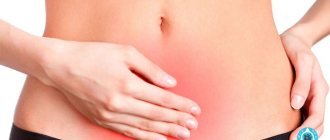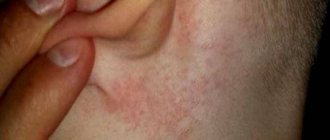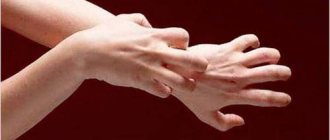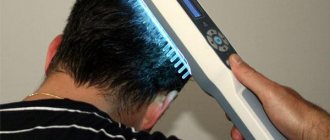What are the possible causes of itching in the neck area? What diseases can cause the neck to itch and turn red on the front, sides and under the chin? What to do if the skin on your neck itches, irritation, redness and rash appear.
Itchy neck is a common dermatological pathology. Typically, the neck itches both in patients with general diseases and in patients with dermatoses. Unpleasant sensations affect the patient’s psychological state, disrupt sleep and reduce quality of life. If the itching on the neck is severe, then you should visit a dermatologist to determine its cause. He will collect a complete history, conduct the necessary studies and only then determine treatment.
Causes
Itching is a normal reaction to an irritant and signals that attention should be paid to a specific area of the skin. Itching can have both physiological and pathological (caused by disease) causes.
Normally, itching and irritation occur due to exposure to damaging factors:
- rubbing with rough seams or accessories;
- bites of blood-sucking insects;
- microdamages when shaving;
- influence of natural factors.
Minor sunburn causes itching and redness. Mostly people involved in agriculture are exposed to such troubles. Severe sunburns can occur with intoxication, severe redness, and the formation of blisters filled with liquid.
Insect bites are also characterized by skin itching and redness. The skin at the site of the bite hurts and swells. A single bite without signs of allergy is not dangerous. But if there are many bites and difficulty breathing occurs, you should urgently seek medical help. Swelling of the larynx and other dangerous allergic reactions are possible.
Mechanical impacts such as frequent shaving, wearing massive metal jewelry, and rough collars on clothes can lead to irritation and itching in the neck area. But if things can be replaced, then it is impossible to completely abandon shaving. To avoid irritation of the facial skin, you should use only a new disposable razor, and also use softening shaving creams and regenerating serums.
Home Remedies
Suitable if not associated with a disease. The disease must be treated by an appropriate specialist.
Cold water
Low temperatures affect nerve endings. Just apply a cloth soaked in cold water or take a cool shower.
When using ice cubes that can be prepared with herbal infusions, be sure to wrap them in a towel or napkin.
Fresh mint
Peppermint contains anti-inflammatory and anesthetic agents that help reduce itching. Brewing the herb releases essential oils. In addition, it contains menthol, which pleasantly cools the skin.
Use a cotton swab to apply the decoction. You can moisten a napkin and apply it to the problem area.
Basil
Basil contains eugenol, which has a local anesthetic effect.
Add about 14 grams of basil leaves to a half-liter jar of hot water. Then close and let cool.
Dampen a tissue or cotton swab and apply to itchy skin.
Thyme
Thyme contains a volatile substance called thymol. Thymol has anesthetic and anti-inflammatory properties, thereby simultaneously anesthetizing and reducing inflammation.
Prepare the decoction as in the previous recipe.
Apple vinegar
Just put a few drops of vinegar on a cotton pad and apply to the problem area.
Apple cider vinegar has antiseptic, antifungal and antibacterial properties. Thanks to these properties, it eliminates itching caused by dry skin.
Aloe
Aloe has antifungal, antibacterial and anti-inflammatory properties. Contains vitamin E, which reduces inflammation, itching, and moisturizes the skin.
Break off a leaf from the plant. Cut lengthwise and apply to the problem area. No aloe? The pharmacy sells gel.
It is not recommended to apply to open wounds or scratches.
Baking soda
To apply to a small area of skin, mix 1 part baking soda with 3 parts water. Apply with a disc or swab to the problem area.
When bathing, add 1 glass to the bath. Duration of reception is 30-60 minutes.
Oatmeal
A well-proven and proven remedy for solving many skin problems.
It is used in the form of a mask, which is applied in a thick layer. It is better to make a mask from ground cereal.
When bathing, add 2 cups of oatmeal to the water. The duration of the procedure is 20-30 minutes. Baths can be taken every day.
Coconut or other oil
Oils moisturize the skin well, eliminating dryness, which is often the cause of itching. Especially in the heat or during the heating season, when the air in the room is very dry.
After applying cosmetic oil, let it absorb. Remove the remains with a napkin.
Decoctions of medicinal herbs, such as:
Calendula;
Chamomile;
Sage;
Dandelion flowers.
There are many ways to get rid of itching in the neck, décolleté, and chest. If your skin itches from sunburn, dry air, irritation from a woolen scarf, or another reason that is not related to illness, home remedies can help.
Why does your skin itch in the “Live Healthy” program?
Source: ekolekar.com
Allergic reactions
Often, wearing metal accessories can cause neck itching, especially in the summer. If you are allergic to certain metals, then you should completely abandon such jewelry or replace them with products made from other materials.
Sometimes irritation occurs due to the fact that the skin under the accessory sweats a lot. To avoid this phenomenon, you must follow these recommendations:
- wear jewelry for no more than 4–6 hours;
- do not wear them in the summer heat;
- wash or clean products once a week;
- shower regularly.
Often the cause of itching in the neck area is an allergy to cosmetics and hygiene products. In case of hypersensitivity, it is recommended to use phosphate-free baby powder or gel. All chemicals (deodorants, lotions, eau de toilette) can cause an allergic rash on the neck.
To find out why the rash may occur, you should reconstruct the course of events and understand what product purchased the day before could have caused such a phenomenon. If you cannot find out what caused the allergy, you need to visit a doctor and have allergy tests done.
If you know that your neck itches due to an allergic reaction, then you should avoid contact with the irritant and take an antihistamine (Tavegil, Suprastin).
What to do if the back of your neck itches
If the skin on the back itches due to sunburn, then Bepanten, Panthenol, Psilo-balm ointment will help. When bubbles form, use Olazol aerosol or Rescue balm.
Allergy to metal
If you are allergic to metal jewelry, be sure to remove it and not wear it again. Places of irritation are lubricated with a thin layer of Prednisolone or Hydrocortisone ointment for up to 5 days, then the residual effects are removed with Aloe liniment or Calendula ointment, Flotseta gel.
Psoriasis
The treatment regimen for psoriasis includes:
- sufficient duration of sleep and daytime rest;
- natural soothing: Persen, Phytosedan, peony tincture;
- hypoallergenic diet;
- antihistamines: Tavegil, Claritin;
- diuretics: Diacarb;
- ointments with hormones: Betamethasone, Lokoid;
- local antipruritics: Daivonex, Eplan, Protopic;
- absorbable external preparations: Ichthyol ointment, with birch tar (Berestin solution).
Osteochondrosis
At the initial stage of cervical osteochondrosis, massage and rubbing of ointments with a warming effect (Finalgon, Viprosal, Nicoflex) are indicated. Acupuncture, amplipulse, ultrasound, darsonvalization help well. Therapeutic gymnastics must be prescribed.
Seborrheic dermatitis
For the treatment of seborrheic dermatitis it is recommended:
- hypoallergenic diet;
- antifungal drugs: Miconazole, Nizoral;
- antipruritic combined ointments: Pimafukort, Candiderm.
Physiotherapy procedures include:
- cryomassage;
- high-frequency currents according to Darsonval;
- ultrasound and phonophoresis Hydrocortisone.
The neck itches due to allergies, burns, psoriasis, eczema, dermatitis, and can also be caused by a disease of the thyroid gland or cervical spine. Persistent itching is typical for scabies and demodicosis. Scratching can be complicated by infection.
Pathology of the thyroid gland
The disease caused by hypersecretion of thyroid hormones (hyperthyroidism) causes increased metabolism, marked loss of body weight with increased appetite, problems with childbearing, and emotional lability.
Symptoms of the disease include the following:
- there is constant weakness, severe thirst and polyuria;
- the front of the neck itches;
- the palpebral fissure increases with the apple shifting forward;
- tachycardia and rapid breathing occur;
- hair becomes thinner and loses melanin;
- heat production increases (the patient sweats and does not tolerate heat well).
If at least some of the symptoms are present, it is necessary to contact an endocrinologist as soon as possible and get tested for hormones and undergo an ultrasound of the gland.
Hyperthyroidism
When talking about conditions that can cause serious problems with the neck, we cannot fail to mention diseases of the thyroid gland. If you feel like scratching the skin on the front of your neck, this may be the first symptom indicating the development of hyperthyroidism.
This disease develops due to increased production of thyroid hormones - thyroxine and triiodothyronine.
The result is a disruption of metabolic processes in the body, an unbalanced emotional state, and rapid weight gain.
With this disease, a diffuse toxic goiter swells in the front of the neck. This sign is complemented by other symptoms: enlarged thyroid gland, bulging eyes, problems with heart function, increased body temperature in some areas. When the thyroid gland is overactive, the skin becomes hot, moist and constantly itchy. If such symptoms appear, you should immediately consult an endocrinologist.
Fungal infections
Pityriasis versicolor is characterized by small areas of lesions that merge together. This fungal disease causes itching and flaking of the skin. The spots have a yellowish tint, but over time their color becomes reddish-brown.
Another common fungal disease that affects the skin of the neck is microsporia. In this case, the scalp is most often affected, and then the lichen spreads to the neck, face and the entire chest. This stage is characterized by itchy skin. The lesions have a round or oval shape. A characteristic feature is peeling in the middle of the lesions and brighter edges.
Squamosal lichen
Another possible cause of itchy skin on the neck is psoriasis. This is a chronic non-infectious disease that affects the dermis. Usually, scaly lichen is manifested by the formation of papules - red, dry spots raised above the surface of the skin. These formations are usually localized on the face, in the bends of the elbows and knees, in the groin, in the neck, but can appear in any other place.
Guttate psoriasis is most often diagnosed in the cervical region. Papules in this case have the shape of tears, circles, droplets. Psoriatic plaques can spread to the scalp, chest, back and shoulders.
The causes of psoriasis have not been precisely established by science, but it is believed that a genetic factor is important. The development of the disease can be provoked by the consumption of alcohol, chocolate or cocoa, marinades, pickles, coffee, as well as some medications. The duration of the course of drug therapy ranges from 6 months to 2 years.
Skin mite infestation
The causative agent of demodicosis primarily affects the cheeks and forehead, but can spread to the chin and below. In advanced forms, the lesion occupies the chest and neck, sometimes the back. The patient notes severe itching, hyperemia, and a rash on the neck.
Demodex multiplies in the ducts of the glands and may not be detected for a long time. With a decrease in immunity or severe internal diseases, it becomes more active and begins its activity, causing redness and rashes on the skin. Trying to get rid of them using folk remedies is impractical; you should visit a doctor and undergo an examination. It is necessary to find out why the decrease in immunity occurred.
Demodicosis
Demodectic mange is caused by the bite of an acne mite. These parasites usually live in the hair follicles and sebaceous glands of the skin. As a rule, the symptoms of the disease are recorded on the face, but can also affect the cervical-collar area.
In severe cases, signs of demodicosis spread to the back and chest.
The painful condition is accompanied by rashes on the skin in the area affected by the tick. The wounds can fester, causing redness, burning, and itching. The development of pathology can be stimulated by decreased immunity, diseases of internal organs (kidneys, stomach, intestines), and endocrine disorders. Demodicosis is usually seasonal. Exacerbations most often occur in spring and autumn.
Often people try to hide the symptoms of the disease under clothing or with cosmetics and treat them with improvised means, but this is not a solution. To diagnose demodicosis, special studies are required, and treatment of the disease is complex and lengthy, so you should not postpone a visit to the doctor.
Psoriasis
This disease is characterized by the appearance of scaly patches and itchy skin. Lesions appear on the face, trunk, inner limbs and neck. It is still not known why it occurs, but there is an assumption that psoriasis has a hereditary predisposition. Provoking factors are severe nervous shock, severe infectious diseases, injuries and sudden climate change.
Guttate psoriasis most often occurs in the neck area. This form is distinguished by foci in the form of drops or circles. The lesion occupies large areas of the body: the upper and lower extremities, the head under the hairline, extends to the back of the neck, the back of the head, the back and sides. Itching intensifies after certain foods and alcohol, so diet is important in therapy.
Treatment of itching occurs only after its cause has been established. If the itching is caused by an allergy, then antihistamines and an antipruritic cream are prescribed. You can make lotions from a decoction of calendula, chamomile or string. For illnesses caused by stress, a daily routine and sedatives are necessary. If the neck begins to hurt and itch in the area of the thyroid gland, then treatment should be entrusted to an endocrinologist.
The neck itches due to insect bites, mechanical stress, burns, wounds, scratches, medications, sweat.
Pathological itching
Skin itching in the cervical-collar region can also be a harbinger of various diseases. Its causes are the following pathologies:
- allergy;
- psoriasis;
- hyperfunction of the thyroid gland;
- fungal skin infections;
- demodicosis
When it comes to pathological itching, the treatment strategy is aimed primarily at eliminating the underlying disease. Infectious diseases deserve special attention: demodicosis and fungal infections of the skin. To avoid transmitting the pathogen to others, patients should strictly observe the rules of personal hygiene.
Allergy
It has been established that women suffer from itchy skin in the cervical area more often than men. Often the reason for this is a reaction to the bra material. Synthetic underwear can cause contact dermatitis, the external manifestations of which are redness and burning in the décolleté and neck area. In this regard, it is recommended to give preference to bras made from natural materials.
Contact dermatitis in the cervical area also develops as a reaction to laundry detergent or detergent: soap, shower gel, etc. By replacing them with analogs that are less aggressive in composition, you can completely get rid of unpleasant symptoms.
Atopic dermatitis requires a more serious approach. Unlike contact, it occurs in response to allergens entering the body. Most often, the disease first appears in children under one year of age. Symptoms of atopic dermatitis include redness, itching, crusting and small bumps on the skin of the face, neck, abdomen and extremities.
Psoriasis
Psoriasis is characterized by chronic inflammation and peeling of the skin. The disease leads to the formation of itchy spots on the body, facial skin, extensor surfaces of the limbs, and in the neck area. The causes of psoriasis are not fully understood, but it has been proven that it has a genetic predisposition. The development of pathology is provoked by injuries, viral and bacterial infections, stress, and sudden climate change.
Guttate psoriasis is most often localized in the cervical area. With this form of the disease, the skin becomes covered with small dry spots in the form of tears, circles, and dots. Damage affects large areas of the body: limbs, scalp, extending to the back of the neck, shoulders and back.
Psoriatic plaques are thickened compared to healthy skin and raised above its level. Their distinguishing feature is a flaky gray or silvery surface. With psoriasis, itching develops as a result of dry skin. It is observed in 80% of patients and can have varying degrees of intensity. It has been established that burning of the body in psoriasis is provoked by alcohol, food allergens (chocolate, coffee, fish, spices) and some medications.
Hyperthyroidism
Skin itching of the cervical area, localized in the thyroid gland, can warn of the development of diffuse toxic goiter (hyperthyroidism). The following symptoms accompanying burning should be alert:
- enlargement of the thyroid gland;
- rapid heartbeat (tachycardia);
- goggle-eyed.
Diffuse toxic goiter is a disease caused by excessive production of thyroid hormones by the thyroid gland. Endocrine changes in this pathology lead to metabolic disorders and excessive accumulation of uncharacteristic metabolites in tissues that have an irritating effect. The integument of the body with hyperthyroidism is hot and moist, which is an additional factor that provokes the development of itching.
Fungal infections
Extensive redness of the neck and décolleté, formed by small merging spots, is a sign of pityriasis versicolor. The disease is caused by a yeast-like fungus. The main symptoms of the pathology are peeling and itching. The second name for pityriasis versicolor is color. It is due to the fact that initially the affected areas are yellowish in color, and subsequently become reddish-brown.
Another cause of a burning neck is ringworm. With this pathology, the scalp is primarily affected. Further, the lesions spread to the neck, face and chest. At this stage, skin itching begins. Rashes localized with ringworm outside the scalp have a round shape, are distinguished by the presence of a bright contour and a light, flaky center.
Demodicosis
When listing the reasons why skin itching in the cervical-collar area develops, it is worth mentioning the disease caused by the demodex mite. The pathogen primarily affects the skin of the face, but can spread below. In severe cases, demodicosis affects the neck, back and chest. Patients complain of severe itching and burning, redness, various forms of rashes and suppuration.
The mite lives in the ducts of the sebaceous glands and hair follicles. Its aggression can be stimulated by factors that provoke a decrease in immunity, endocrine disorders, pathologies of the kidneys and gastrointestinal tract.
Burning of the neck skin is most often accompanied by redness and rashes. This is not only unpleasant, but also aesthetically unattractive. However, you should not try to hide the affected area and get rid of the itching symptomatically. This approach can only aggravate the situation, because burning of the skin often accompanies serious diseases that require treatment.
Source: tutzud.ru
Symptoms, how to treat
If your neck itches constantly, consult a specialist. It may be a dermatological disease. It could be hair mites, lice, or fungus. Symptoms: itching, blisters, crusts, swelling.
The problem may be dry skin. Wash your hair less often, use a hairdryer less, use moisturizing and nourishing masks. If you have a burn or insect bite, use appropriate medication. The problem may be acne, diseases of the digestive system, or neglect of hygiene. Shaving can cause itching.
Medifox emulsions, Wilkinson ointment, sulfur ointment, Zyrtec, Claritin help. Sage and chamomile help. As a preventive measure, use proven cosmetics, treat emerging diseases in a timely manner, and undergo examinations. More details about the problem below.
Physiological etiology
Common causes of physiological itching:
- insect bites;
- mechanical influences (friction of synthetic or woolen clothing, metal jewelry);
- sunburn;
- damage to the skin during shaving;
- increased sensitivity of the skin in the chin area.
Allergies to medications, cosmetics, household chemicals, etc. can provoke itching.
Constant stay in rooms with high humidity, as well as frequent stressful situations, cause irritation of the skin.
Symptoms
The situation with an aesthetic scourge that affects the neck and back of the head, hidden under the hairline, is dangerous because it is initially not intrusive and does not prompt a person to urgently run to the doctor. But the lack of adequate therapy in this case can lead to a rapid worsening of the problem.
Most often, this scourge affects women and children. This factor is connected with the fact that in the everyday life of the fairer sex there are a large number of allergens (shampoos, conditioners, masks and hair dyes), and children's bodies are more susceptible to irritating external factors.
The development of an aesthetic problem in them can be determined by the appearance of characteristic rashes and redness, as well as the following negative signs:
- the skin begins to peel off intensively, and particles of crumbled epidermis cover the clothes;
- a rough coating appears on the skin, and crusts and blisters may also form;
- There is a constant sensation of itching, which cannot be relieved by any scratching of the skin.
In some cases, this negative phenomenon may be accompanied by a rise in temperature, increased lacrimation and swelling. Over time, the itching will spread wider and wider, covering neighboring areas.
External factors
The cause of the disease may be a violation of human food hygiene rules or a negative impact on the environment. Therefore, before going to a specialist, you need to analyze your actions over the past few days, as well as study the hygiene products that are used for hair care. This must be done because the most common reasons why the back of the head and head often itch are the following:
- An allergic reaction that occurs when using certain hair care products.
- Intolerance to hair dyes containing hydrogen peroxide or ammonia.
Constant scratching at the back of the head can also be caused by constantly blow-drying your hair with a hot hair dryer, washing your hair frequently, or staying in direct sunlight for long periods of time without covering your head. These factors lead to dryness of the epidermis of the scalp and, as a result, to the appearance of a rash.
The occurrence of this aesthetic pathology is greatly influenced by psycho-emotional overload or frequent stress. Due to their effect on the body, increased production of adrenaline begins, an increased amount of which causes skin itching.
Also, among the circumstances that can provoke unpleasant sensations, experts note excessive mental or prolonged stress.focus. This is due to the fact that such conditions cause emotional fluctuations in a person, contributing to the emergence of negative skin sensations.
What makes a person scratch the skin on the back of his head?
In fact, there are many reasons why the back of the head and neck itches. Itching sensations may be accompanied by redness and irritation of the skin, partial hair loss, rashes and painful blisters.
The main factors that cause discomfort include:
- Skin parasites.
- Allergy to various cosmetics and hygiene products.
- Fungal diseases of the scalp.
- Violation of subcutaneous metabolism.
- Hyperhidrosis of the head.
- General disturbances in the functioning of various body systems.
As soon as the neck and back of the head begin to itch constantly and cause severe discomfort, you should consult a dermatologist. Only in the Medical Center with available laboratory equipment, it is possible to accurately determine the causes of itching.
Itchy neck skin during pregnancy
About 20 percent of women complain about this symptom. Typically not associated with serious illness. This is the result of hormonal changes in a woman's body.
Often, in addition to the neck area, pregnant women have itchy stomach, legs, arms, and chest. Accompanied by dryness, pigment changes and the appearance of stretch marks.
If it persists for a long time, you should consult a specialist so as not to miss the onset of the disease.
One of them is cholestasis of pregnancy, which most often appears in the third trimester. Characterized by itching of the skin of the hands and feet. Then the neck, face and torso.
The symptoms are especially annoying at night. It should not be underestimated, as it can cause complications such as premature birth.
Pregnancy is not the only reason why the skin on the neck or décolleté in women itches. May occur during menopause. This is due to a decrease in estrogen.
This hormone is also responsible for the condition of the skin: firmness, elasticity, moisture. During menopause, the skin becomes dry and thins. This leads to the fact that it becomes irritated and itchy.
Another reason is the development of cancer in this area. If itching persists after 6 weeks, consult a doctor immediately.
The meaning of itching by location
The neck begins to itch in several cases. To understand the signs sent from above, look at where exactly the itching began.
Each specific place has its own sign.
- On right. Itching on the side was considered a sign of hard work. In the past, the groom's parents, when looking for the bride to sleep, tried to see how she scratched her neck. The itching right side said that she would become a good wife and behave correctly. If a girl scratched the back of her neck, she could not be considered an enviable bride. After all, this is a clear sign of laziness.
- Left. For a girl, scratching her neck on the left side is an indicator of homeliness and thriftiness.
- Front. It is known that the front of the neck itches when a person is expecting pleasure. They are expressed in various pleasures for the body and soul. The interpretation for men has its own nuances. If the itching has spread to the Adam's apple area, alcoholic libations are coming. This includes drinking with friends, and the desire to “drown away grief” alone and relax. In any case, itching in the front of the neck indicates that the volume of alcohol will be considerable.
- Behind. The main meaning is also connected with the fight. If a person is not prone to assault, perhaps he will simply “get it in the neck” from his superiors, or someone else will offend him. To avoid conflict, you will have to try and be a model of restraint and correctness in everything. There is a second interpretation, promising a long journey. It will bring a lot of problems, you will have to cope with difficulties in order to achieve what you want.
Causes of itching
Why does the back of my head and neck itch? Most often, doctors identify the following reasons:
- any parasites, including lice, ticks, etc. They can usually be seen with the naked eye, so anyone can ask a friend or acquaintance to look at their head for parasites. In any case, it is better to do this with gloves so that there are no problems with infecting others,
- seborrhea caused by excess sebum production in the scalp area. A common (but not obligatory) symptom is dandruff - actively forming white pieces of dead skin,
- allergy to shampoo. Most often, this symptom spreads to the entire head, but in some cases the back of the head suffers especially badly. Sometimes the cause is not immediately identified because people do not associate sudden itching with a change in shampoo. To avoid a recurrence of the situation, it is enough to monitor the condition after changing shampoo or hair conditioner,
- allergy to hair dye. May be accompanied by hair loss and rashes on the back of the head. A simple test for allergic reactions at least a day before staining allows you to avoid this.
- fungal diseases. Most often they appear after visiting public places (for example, swimming pools or summer camps), although they can sometimes be transmitted from pets. The treatment is quite long and complex: in addition to special shampoos, the trichologist prescribes a course of antifungal drugs, thanks to which the symptoms go away much faster,
- an allergic reaction to the powder and rinse aid used to wash bed linen. Such cases are quite rare, but this cause cannot be completely ruled out, because a poorly washed pillowcase can cause itching on the back of the head (especially if a person is used to sleeping on his back).
Manifestation of allergies to jewelry
Often both women and men wear chains around their necks. Sometimes the alloys they choose may not be suitable for them. Often jewelry can give similar symptoms. As a result, they get to the point where they are very itchy at the points of contact between the body and the metal.
It's easy to test this assumption: just remove the suspected source of discomfort. If the irritation goes away in a few days, then that’s the problem. In order to avoid this in the future, you should avoid massive jewelry (especially in the summer), limit the time the jewelry is in contact with the body (no more than 6 hours) and wipe it with hydrogen peroxide to remove bacteria.
Improper hygiene
If the back of your head and neck itches, the simplest reason may be improper body hygiene. When a person rarely bathes and washes his hair, itching occurs due to the accumulation of dirt, dust and grease. The skin under the layer of dirt does not breathe and itches.
The second reason for severe itching on the neck or head is too frequent washing. If a person bathes several times a day using soap, the skin can dry out from such procedures. If your neck sweats often, you don’t need to wash it with water at every opportunity. It is better to use a wet wipe and take a shower before bed.
Pityriasis versicolor
It is a chronic fungal infection of the upper layer of the dermis that often affects the cervical region. The causative agent of pityriasis versicolor is a yeast-like fungus. This pathology is most often observed in adolescence. It develops especially actively in hot climates. The main symptom of lichen is small spots on the skin. At first they are reddish in color, and then become yellowish-brown. In addition to the neck, such formations often appear on the back, shoulders, chest, and armpits. Pityriasis versicolor causes severe skin irritation and itching.
To diagnose the disease, the so-called Balser test is performed. Tincture of iodine is applied to the affected area. After this, a skin scraping should reveal yeast when examined under a microscope. Treatment is carried out using medicinal methods: special ointments, lotions, shampoos, and gels are applied to the wound so that it does not itch.
For prevention in the warm season, it is recommended to use acidified water or salicylic alcohol, which should be used to wipe stains on the skin. People with pityriasis versicolor should avoid heavy physical exertion, elevated temperatures, and constant stress. Particular attention must be paid to skin hygiene. Clothing should be worn only from natural fabrics (cotton or linen).
Source: allergyastop.ru
Causes of itchy neck not related to disease
You can understand whether a problem is related to a disease or to normal physiology by simply eliminating provoking factors. Let's consider cases when neck itching occurs due to contact with the external environment.
Insect bites
If, upon examination of the skin, small pimples or just a red spot were found, then it is quite possible that an insect recently crawled across this area and stung several times. Mosquitoes, midges, and various types of spiders, of course, are not poisonous, but when they bite, histamine enters the epidermis - the same compound that causes allergies. This is why a person begins to scratch the bite area, and the more he does this, the more intense the itching becomes.
Itchy neck due to illness
Non-communicable diseases
Among such diseases, the following pathological processes in the body can be distinguished:
- Allergy. This is exactly what you should think about if all of the above is excluded. From this point on, self-diagnosis should be stopped. The fact is that there are many types of allergies, and each has its own symptoms. Many of them are similar, so it is completely impossible for a non-professional to distinguish one pathology from another, as well as generally establish whether the body’s immune reaction is the cause of itching on the chin and neck.
- Contact dermatitis. This skin reaction initially occurs acutely, but can also occur with mild symptoms and be disturbing from time to time. Among the provoking factors, household chemicals, cosmetics, and perfumes rank first. The disease manifests itself as follows:
- the area of skin that was touched by the substance or provoking object becomes covered in a rash and peels off;
- redness, swelling, burning appears;
- a deterioration in general health may occur.
- Eczema. The nature of the disease is allergic, however, this is not the only thing that triggers the development of the disease, and not all the reasons have been studied and understood. There are several types of the disease, but some common symptoms can be identified:
- in the area where the lesion occurred, the skin turns red;
- in the same area you can see rashes with pus and serous fluid;
- there is no hair in the affected area;
- the skin peels off, its dry layer comes off, revealing an unhealthy epidermis with scales.
- Lichen planus. There are many reasons that cause this dermatosis: from genetic predisposition to a banal allergy to medications. The following symptoms are characteristic of the disease:
With seborrheic eczema, the skin under the hair on the head begins to itch, but then, if there is no treatment, the itching will spread to the chin and neck.
- monomorphic rash of different shades of red;
- the rashes are grouped in a special way; in general, their clusters resemble a necklace in shape;
- on large papules a network-like pattern is visible (symptom of Wickham's grid);
- In addition to the neck, the rash can also appear on the stomach, behind the ears, and hands.
There are several types of lichen planus, but itching on the back of the neck appears mainly in the moniliform form.
Infections
The most common infectious diseases include:
- Ringworm. This fungal infection is easily transmitted from sick animals (most often cats) and people. The fungus affects both smooth skin and scalp. Initially, a person infected with microsporia notices that a bright pink spot appears on the skin. Over time, this lesion grows and begins to peel off. The shape of the spot is oval or ring-shaped.
- Pityriasis (multi-colored) lichen. Infection occurs if there are conditions suitable for the causative agent of the disease. For example, a person suffers from some endocrine pathology, suffers from a chronic gastrointestinal disease and generally has reduced immunity. Characteristic features:
- the neck itches and becomes covered with asymmetrical spots;
- the affected areas change color, the shade can be anything (pink, gray, brown);
- At the beginning of the disease, the spots are small, scattered, in advanced cases they merge together.
Other reasons
Any strong and sudden stressful situation can also cause intense itching. In some cases, several factors simultaneously trigger an unpleasant skin reaction. It could be:
- smoking;
- kidney disease;
- menopause, pregnancy;
- pathology of the thyroid gland;
- narrowing of the bile ducts;
- helminthic infestation.
The front of the neck itches: causes and treatment
If the front of your neck itches, then for treatment you first need to establish the cause. You can do this yourself if there is a known damaging factor - for example, an insect bite, a burn, but only a dermatologist can establish a diagnosis of a skin disease. If there are signs of damage to the thyroid gland, contact an endocrinologist, and treatment of neurological manifestations of osteochondrosis is carried out by a neurologist.
Scabies
The most popular and affordable drug for treatment is benzyl benzoate emulsion. Before application, wash the entire body and rub the medication into the skin, do not treat only the scalp. Change the linen, wash it in hot water and iron it on both sides. After 2 days, rub in again. An effective, but more expensive remedy is Spregal aerosol.
Insect bites
For itching from bites, use Fenistil gel or Psilo-balm. If there is severe redness and swelling, then they are supplemented by taking tablets with an antiallergic effect: Tavegil, Cetrin, Loratadine.
Goiter, thyroiditis
For goiter due to low hormonal activity of the thyroid gland, iodine (Iodide, Iodomarin) is used, as well as an analogue of the hormone thyroxine (Eutirox, L-Thyroxine Berlin-Chemie). If the increase is associated with high function, then Mercazolil and radioactive iodine are used; if the effectiveness is insufficient, surgery is performed. For autoimmune thyroiditis, hormones (Prednisolone) are used, and the infectious process is stopped with antibiotics (Augmentin).
Hives
For urticaria, antiallergic drugs are used orally: Erius, Allerway, Allegra. Hydrocortisone and Lokoid ointment are applied topically. In the food form, it is recommended to take Activated carbon, laxatives (Regulax picosulfate), probiotics (Hilak forte, Laktofiltrum).
Demodicosis
The chin and front surface of the neck are lubricated with Metronidazole gel. After inflammation subsides, patients are prescribed electrophoresis with hyaluronic acid, and the face is cleansed using microdermabrasion (the top layer of the epidermis is removed). Laser therapy has a good effect.
Eczema
In the acute stage, Pipolfen, Suprastin are used, as they improve, they switch to Cetrin, Loratadine, and with active inflammation, oral Prednisolone and calcium gluconate injections are indicated. Dermovate and Advantan are applied topically, then weaker ones are used - Betamethasone, Hydrocortisone. After the active inflammatory process subsides, laser therapy, cryotherapy (nitrogen applications), and magnetic therapy are prescribed.
Allergies in a child
Be sure to exclude foods with an allergenic effect from the child’s diet. Claritin and Erius syrup are prescribed internally for a short course. Ointments with an antipruritic effect are applied locally - Gistan, Fenistil, and in severe forms, hormonal agents are used (Lokoid, Advantan). Outside of exacerbation, physiotherapy and sanatorium treatment are indicated.
Traditional medicine recipes
You should not pursue big goals if you decide to resort to traditional medicine. A serious illness can hardly be cured in this way, but it is quite possible to make it worse, if only because time is wasted.
- Meanwhile, we can heed the advice we received from healers and healers among the people when it comes to relieving itching. Prepare an oatmeal bath instead of a regular bath. For this purpose, both flakes and cereals will do, in a word, everything that is in the house in the amount of 200 grams. Using a coffee grinder, grind the oatmeal into flour. Dissolve the resulting powder in water and then pour the solution into the bath. Swim for 10-15 minutes.
- Herbal decoctions will also help to cope with the unpleasant symptom. Brew chamomile, string, calendula. Soak a cotton swab in this decoction and wipe the itchy areas. It is enough to repeat the procedure 2-3 times a day.
- If there is redness and intense itching on the neck, there is a high chance that the skin will be damaged. Wounds are entry points for infection. To prevent infection, use alcohol tincture of calendula as a cosmetic lotion. Do wiping only in the affected area. If you decide to prepare the product yourself, you will need:
- 10 g dry calendula;
- 70% alcohol;
- purified water.
Pour crushed plant particles into alcohol. Seal the bottle tightly and keep it in a dark place for 2 weeks. If such a lotion is too stinging for irritated skin, dilute it with water.








